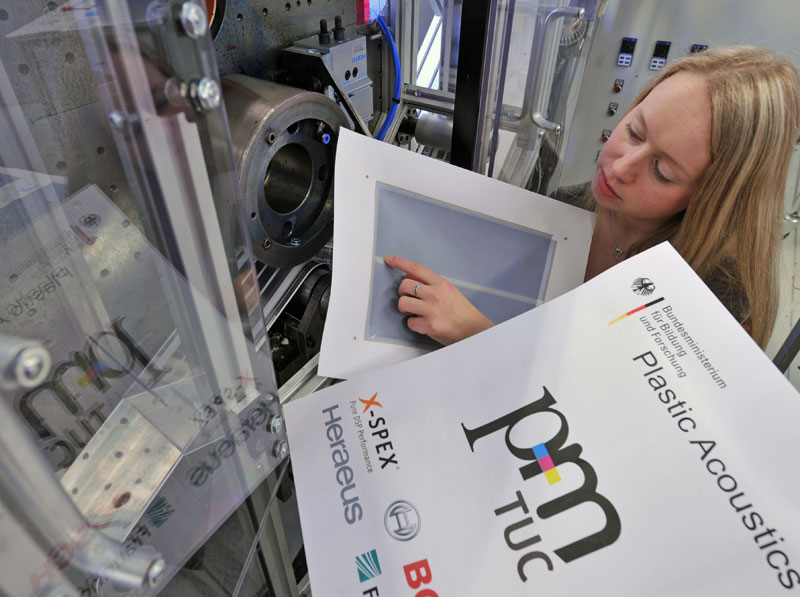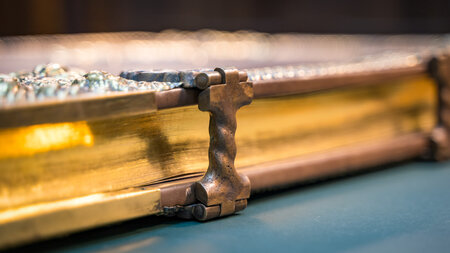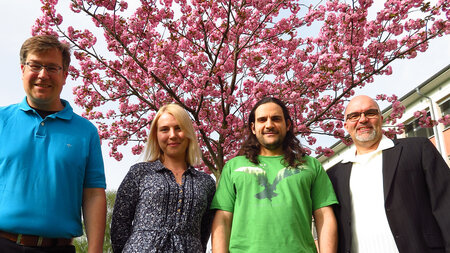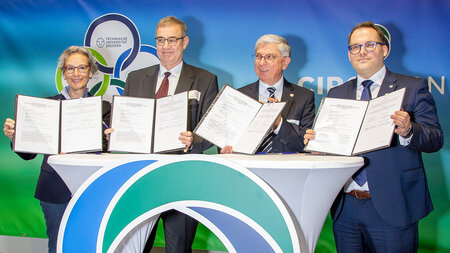Paper with good sound quality
At drupa print media fair, the Institute for Print and Media Technology of Chemnitz University of Technology presents printed loudspeakers on paper substrate and a solar tree with printed solar cells
-

Maxi Bellmann, researcher at the Institute for Print and Media Technology of Chemnitz University of Technology, shows the printed loudspeaker area. The bottom side of the paper loudspeaker can be printed with advertising messages - in this case you can see the logos of the project partners. Photo: Hendrik Schmidt
At drupa, the world’s largest fair on print media technology, which takes place from 3 to 16 May 2012 in Düsseldorf, the Institute for Print and Media Technology of Chemnitz University of Technology (pmTUC) presents new research results, which truly make you prick up your ears: Loudspeakers that have been printed with flexography on standard paper. The R&D group of Prof. Dr. Arved Hübler, head of pmTUC, is co-exhibitor of press manufacturer Windmöller & Hölscher KG (Lengerich) and can be found in hall 15, booth A41/1.
The printed paper loudspeaker is connected to an audio amplifier like a conventional loudspeaker. "Frequency response and hence sound quality are very good and the paper is surprisingly loud. Just the bass of the paper-based loudspeaker is a bit weak”, explains Dr. Georg Schmidt, senior researcher at pmTUC. The thin loudspeakers, which are printed in the laboratories of pmTUC, contain several layers of a conductive organic polymer and a piezoactive layer. According to project assistant Maxi Bellmann the loudspeakers are astonishingly robust and can be produced in a very cheap way as mass printing methods are used. The bottom side of the paper loudspeaker provides unused space on which coloured messages can be printed.
Prof. Hübler expects a broad range of new applications: The paper loudspeakers could, for instance, be integrated into common print products. As such, they offer an enormous potential for the advertising segment. "In addition, sound wallpapers and purely technical applications, e.g., distance sensors, are possible, because the papers are also active in the ultrasound range”, says Hübler and adds: "As printing allows for different formats and forms, there is the possibility to influence the generated sound waves.” The loudspeaker of pmTUC was realised within the framework of the project Plastic Acoustics (PACU), which is funded by the Federal Ministry of Education and Research and includes the following project partners: Robert Bosch GmbH (Stuttgart), Heraeus Clevios GmbH (Leverkusen), X-Spex GmbH (Berlin), and Fraunhofer Institute for Electronic Nano Systems ENAS (Chemnitz).
Electricity that grows on trees
Besides printed loudspeakers, pmTUC presents innovative application scenarios for printed solar cells. "Half a year ago, we introduced the world’s first 3PV technology - printed paper photovoltaics, says Hübler. At drupa, the Chemnitz researchers exhibit a solar tree with 50 printed solar leaves. Similar to an ordinary tree, the leaves that face the sun collect energy. They are connected with snap fasteners. Via a cable in the hollow tree trunk the solar electricity supplies a battery.
"If you stand below the tree and look up to the shade-giving leaves of the solar tree, you can see that the bottom side of the leaves is printed with advertisements”, explains Hübler and adds with a twinkle in his eye: "That’s even better than in nature.” Because according to Hübler, the advertising segment is the driving force of the printing industry: "As soon as the customer realises that it is better to not throw advertising that contains a solar cell away, but rather keep it to generate electricity for some time, the printed solar cell will become an unbeatable advertising carrier with a sustainable image”, reports the professor from Chemnitz. Hübler does not only believe that the 3PV technology, developed at Chemnitz University of Technology, will make a contribution to global power supplies in the future, but also that 3PV will bring about the breakthrough of printed electronics.
In his book "print becomes electronics”, which is published in English and German on occasion of drupa, Hübler analyses the backgrounds of this development and explains the transition that he expects to take place in the traditional graphic arts industry. According to Hübler, electronic media and conventional print media will increasingly merge in the future: "A large part of electronics will be printed, and most print media will be electronic.” The book is available at drupa and upon request from pmTUC.
Contact:
Prof. Dr. Arved Hübler, phone +49(0)371 531-23610, email pmhuebler@mb.tu-chemnitz.de, and Sylvia Strauß, phone +49(0)371 531-35501, email sylvia.strauss@mb.tu-chemnitz.de
Homepage: http://www.tu-chemnitz.de/pm
3PV technology: http://www.pppv.de
The pmTUC shows impressions from the booth in a video: http://www.youtube.com/watch?v=YPzj5IvoGA4
(Translation: Sylvia Strauß)
Katharina Thehos
02.05.2012





